family

 My nephew, Jason Sawdon is a great guy…just ask anyone who knows him. His sister-in-law, Chelsea Hadlock tells me that Jason is kind, helpful, and sister-in-law, Lindsay Moore says that he has a generous heart, which she believes to be straight from the Lord. Jason is always willing to help others with a variety of things. He helps out his church in Cheyenne, Wyoming, with their computer things, like streaming their services online, which is such an important part of church services these days. If people are sick, or just can’t get out of their home easily, they don’t have to miss out on the church service. Jason serves others gladly and with compassion. He is so handy and can truly figure anything out!!
My nephew, Jason Sawdon is a great guy…just ask anyone who knows him. His sister-in-law, Chelsea Hadlock tells me that Jason is kind, helpful, and sister-in-law, Lindsay Moore says that he has a generous heart, which she believes to be straight from the Lord. Jason is always willing to help others with a variety of things. He helps out his church in Cheyenne, Wyoming, with their computer things, like streaming their services online, which is such an important part of church services these days. If people are sick, or just can’t get out of their home easily, they don’t have to miss out on the church service. Jason serves others gladly and with compassion. He is so handy and can truly figure anything out!!
Jason is dependable. If Jason says he will be there to help…he will. This past week, he helped his father-in-law, Chris Hadlock with the electrical work in Chris’ new garage. Jason did a great job on the wiring for the garage. It will be inspected next week, and they are confident it will get the green light. He has a lot of talent when it comes to electricity and engineering…a great plus, in the “saving money” arena. If you can save money, it’s a good thing. Having that help within the family is awesome.
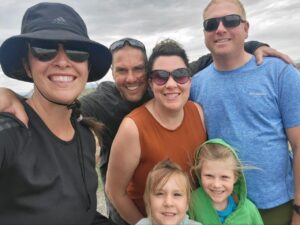
 Everyone tells me that Jason is also funny, but not in an obvious way!! You really can’t tell he’s joking unless you know him well!! Those are the best tricksters, because they will get you every time. Not everyone can tell a good joke or pull a really great prank with a straight face, and if you can’t, the prank with never go over. You have to have a “poker face” so to speak. Jason is quite a character, he and brings lots of fun and adventure to their lives!! Everyone feels blessed to have him as a brother-in-law, they love him very much. I don’t know anyone who wouldn’t agree with them on that.
Everyone tells me that Jason is also funny, but not in an obvious way!! You really can’t tell he’s joking unless you know him well!! Those are the best tricksters, because they will get you every time. Not everyone can tell a good joke or pull a really great prank with a straight face, and if you can’t, the prank with never go over. You have to have a “poker face” so to speak. Jason is quite a character, he and brings lots of fun and adventure to their lives!! Everyone feels blessed to have him as a brother-in-law, they love him very much. I don’t know anyone who wouldn’t agree with them on that.
In a “Wild Hogs” kind of time, Jason went on a motorcycle trip with his friends this summer. They went on some backroads trails across the state of Wyoming. They had a great time. Now, I don’t know if they got into as much mischief as the original “Wild Hogs,” but I’d say probably not. Jason, being a Wyoming 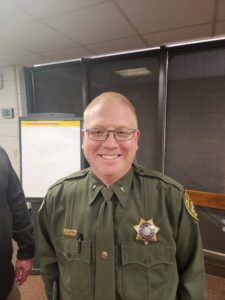
 Highway Patrol Lieutenant, would be very unlikely to get into any trouble, and my guess is that at least some of his friends are also law enforcement, so…getting in trouble is not an option, Haha!!
Highway Patrol Lieutenant, would be very unlikely to get into any trouble, and my guess is that at least some of his friends are also law enforcement, so…getting in trouble is not an option, Haha!!
My sister, Allyn Hadlock, Jason’s mother-in-law, like every mom, takes a different view about what traits are most important in her son-in-law, and Jason has gained her approval in every area. He is a great dad and husband. He is always happy to indulge, his wife, Jessi’s whims!! He’s a great guide to their daughter, Adelaide and loves her so much!! They have a lot of fun as a family, camping, traveling, or just time at home hanging out together. Allyn says, “We are very blessed to have Jason in our family!!” Today is Jason’s birthday!! Happy birthday Jason!! Have a great day!! We love you!!

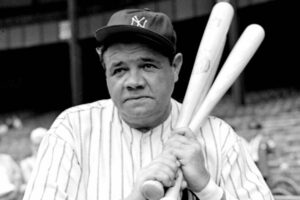 My dad, Al Spencer, and my niece, Liz Masterson, as well as other of my family members New York Yankees baseball team. Of course, lots of us know about the famous, Babe Ruth and his historic baseball abilities…specifically his famous records, such as an astonishing 56 major league records at the time of his retirement in 1935, including the most revered record in baseball…714 homeruns. Ruth was the first player in baseball history to hit 700 home runs, and he won seven World Series titles, including four with the New York Yankees. His record was the reason that Yankee Stadium was called “the house that Babe Ruth built.”
My dad, Al Spencer, and my niece, Liz Masterson, as well as other of my family members New York Yankees baseball team. Of course, lots of us know about the famous, Babe Ruth and his historic baseball abilities…specifically his famous records, such as an astonishing 56 major league records at the time of his retirement in 1935, including the most revered record in baseball…714 homeruns. Ruth was the first player in baseball history to hit 700 home runs, and he won seven World Series titles, including four with the New York Yankees. His record was the reason that Yankee Stadium was called “the house that Babe Ruth built.”
Of course, as we all know, all good things must come to an end, and the old Yankee Stadium was no exception. The Stadium with its unique design, such as a short porch in right field and covered seats in deep center opened in 1923. The beloved stadium was the scene of scores of Major League Baseball’s most famous moments, including Ruth’s first home run in the stadium on April 18, 1923, Reggie Jackson’s three home-run game to close out the 1977 World Series, and Aaron Boone’s Game 7 walk-off home run in the 2003 American League Championship Series against the Boston Red Sox.
Now, the stadium was getting old, and finally, on September 21, 2008, the stadium witnessed its final game being played. I’m sure it was a sad moment for many Yankees fans. To think that the iconic stadium would cease to exist most likely brought tears to the eyes of many loyal fans. Thankfully, the stadium went down with a win against the Baltimore Orioles, 7-3. Future Hall of Famer Mariano Rivera closed the game with a perfect ninth inning. Who could have asked for anything more…other than maybe not closing down the stadium. Yankees pitcher, Andy Pettitte said, “The way I feel emotionally right now and just physically so drained, it feels like a huge postseason win for us.”
The stadium would go out in typical reverence. The Yankees hosted a pre-game ceremony, allowing fans and former Yankee legends to walk the hallowed grounds a final time. Julia Ruth Stevens, Ruth’s daughter, threw out the ceremonial first pitch as the scoreboard flashed “To Be Continued…” and a photo of “The Bambino” winking. While the iconic final game meant a lot to many people, it was ultimately meaningless in the standings for the 2008 Yankees, who in an ultimately underwhelming season, would miss the playoffs for the first time in more than a decade. But veteran Yankees noted a playoff-like atmosphere. Even some of the retired Yankees, such as Bernie Williams, described pre-game jitters, saying, “I feel as nervous as I was before a playoff game.”
In an effort to encourage the fans who were sad to see the old stadium go, Yankees captain Derek Jeter told the New York faithful to bring the same energy to the “new” Yankee Stadium the next season. “We are relying on you to take the memories from this stadium, add them to the new memories to come at the new Yankee Stadium, and continue to pass them on from generation to generation,” he said. While the 2008 Yankees couldn’t pull off a trip to the playoffs, the 2009 Yankees managed to win another World Series…the fifth and final one of Jeter’s historic career. As for the old Yankee Stadium, it was demolished in 2010, and the site was converted into a public park called Heritage Field. Heritage Field is located on the same plot of land previously occupied by the original Yankee Stadium. It was finally completed in 2012. In a strange twist, there is very little recognition of the history of the ballpark that once stood there. There are only four benches and numerous 
 pavers that list various events that occurred at Yankee Stadium. The site has no featured plaque which describes exactly what was on this spot previously. As to the original Yankee Stadium, the only thing remaining is a large piece of frieze, located in what was the outfield. Heritage Field is nice, but there is a sense of something missing, because of the lack of enough recognition of Yankees baseball history.
pavers that list various events that occurred at Yankee Stadium. The site has no featured plaque which describes exactly what was on this spot previously. As to the original Yankee Stadium, the only thing remaining is a large piece of frieze, located in what was the outfield. Heritage Field is nice, but there is a sense of something missing, because of the lack of enough recognition of Yankees baseball history.
 Margaret Haughery was a philanthropist in the New Orleans area. A philanthropist is “a person who seeks to promote the welfare of others, especially by the generous donation of money to good causes.” She was well known as “the mother of the orphans.” Margaret Gaffney Haughery was such a kind and loving person, and in 1880s New Orleans, she was beyond loved. She was so loved that she was known as “Our Margaret,” “The Bread Woman of New Orleans” and “Mother of Orphans.” The reason, Haughery is so loved is that she devoted her life’s work to the care and feeding of the poor and hungry, and to fund and build orphanages throughout the city.
Margaret Haughery was a philanthropist in the New Orleans area. A philanthropist is “a person who seeks to promote the welfare of others, especially by the generous donation of money to good causes.” She was well known as “the mother of the orphans.” Margaret Gaffney Haughery was such a kind and loving person, and in 1880s New Orleans, she was beyond loved. She was so loved that she was known as “Our Margaret,” “The Bread Woman of New Orleans” and “Mother of Orphans.” The reason, Haughery is so loved is that she devoted her life’s work to the care and feeding of the poor and hungry, and to fund and build orphanages throughout the city.
Haughery was an Irish immigrant, and she was also a widow. Haughery held many titles. She was commonly referred to as the “Angel of the Delta,” “Mother Margaret,” “Margaret of New Orleans,” the “Celebrated Margaret,” “Head Mame,” and “Margaret of Tully.” A Catholic, she worked closely with New Orleans Sisters of Charity, associated with the Roman Catholic Archdiocese of New Orleans. Her work was mainly with poor and orphaned widows and kids. She opened four orphanages in the New Orleans area in the 19th century. She didn’t stop there, however. Many years later in the 20th and 21st centuries, several of the asylums Margaret founded as places of shelter for orphans and widows evolved into homes for the elderly.
After her many long years of working with the needy, Haughery, a woman known for her great work in charity, became famed for her lifelong championing of the destitute. Some people considered her a living saint worthy of canonization. Haughery didn’t have a wealthy start. On the contrary, she was born into poverty and orphaned at a young age. She struggled most of her young life. She then began her adult life as a washwoman and a peddler. Nevertheless, she died a businesswoman and philanthropist and received a state funeral. Her life proves what is said in Luke 6:38 in the Bible, “Give, and it will be given to you. Good measure, pressed down, shaken together, running over, will be put into your lap. For with the measure you use it will be measured back to you.” Haughery was an extravagant giver. It doesn’t mean that she gave tons of money, although over the years, she did. Nevertheless, she gave as much as she could, sometimes even more.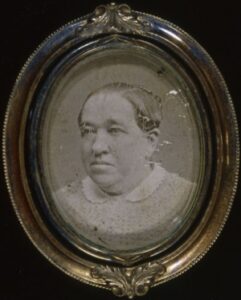
Margaret was born in a stone cottage in Ireland in 1813, the fifth child of William and Margaret O’Rourke Gaffney. The family fell on hard times and the family divided, leaving the three younger children in Ireland with William’s brother. Before long the rest of her family died or, as in the case of her brother, ran off. Haughery was alone and homeless. A Mrs. Richards, who had made the overseas crossing with the Gaffney family heard of Margaret’s plight. She had lost her husband to yellow fever. She took Margaret into her home. There Margaret remained for some years, where she worked for her keep. In fact, she may have been little more than a servant. Margaret received no formal education, and never learned to read or write. When old enough, Margaret went into domestic service, which was common for Irishwomen in Baltimore at that time. While she basically started out with nothing, she received the “kindness” of Mrs Richards and then turned her life around. Margaret went on to show kindness to so many others, and in the end, she became one of the most beloved women in New Orleans.
Margaret married Irish-born Charles Haughery on October 10, 1835, when she was 21 years old. Margaret persuaded him that a change in climate might be therapeutic for his poor health. So, they moved south. They left Baltimore on the ship Hyperion and reached New Orleans on November 20, 1835. Unfortunately, New Orleans was in the middle of yellow fever and cholera epidemics. For a time, Charles’ health showed a slight improvement, but it was short-lived and medical advice recommended a sea journey. In desperation, Charles decided to go to Ireland, which was his native land. The trip had to be delayed for several months pending the birth of the couple’s first child, a girl named Frances. Eventually, Charles made the voyage but after some months Margaret received word that he died shortly after reaching his destination. A short time later, Frances became seriously ill and died. Once again, Margaret’s family was wiped out, and she was just 23 years old. At this point, Margaret Haughery could have given up in despair, but she didn’t. She turned her life around and became one of the most beloved women in New Orleans.
In her will Margaret left everything to charities, without distinction of religion, for widows, orphans, and the 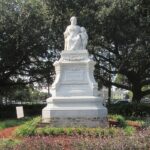 elderly. She left all her wealth to charities with the exception of the bakery, which she bequeathed to her foster son, Bernard Klotz. According to her will, the rest of her wealth. When Margaret died and her will was read, with all her giving, she had still saved a great deal of money. She somehow had given so much, and still had more to give. She left every cent of it to the different orphan asylums of the city. Each orphanage was given something, whether they were for white children or black, for Jews, Catholics, or Protestants, made no difference. Margaret always said, “They are all orphans alike.” Margaret signed her will with a cross instead of a name as she never learned to read or write. Her signature, a reminder of her humble beginnings, great business successes, and mark on humanity, despite being unable to read or write.
elderly. She left all her wealth to charities with the exception of the bakery, which she bequeathed to her foster son, Bernard Klotz. According to her will, the rest of her wealth. When Margaret died and her will was read, with all her giving, she had still saved a great deal of money. She somehow had given so much, and still had more to give. She left every cent of it to the different orphan asylums of the city. Each orphanage was given something, whether they were for white children or black, for Jews, Catholics, or Protestants, made no difference. Margaret always said, “They are all orphans alike.” Margaret signed her will with a cross instead of a name as she never learned to read or write. Her signature, a reminder of her humble beginnings, great business successes, and mark on humanity, despite being unable to read or write.
 Very often, those we would least expect to rise to greatness, show us just how wrong we were. Grace Murray Hopper, at a very young age showed an interest in engineering. She could often be found taking household goods apart. Still, lots of kids have taken things apart, but then Grace would put them back together too. Still, her family had no idea that her curiosity would eventually gain her recognition from the highest office in the land. She was just a curious kid…right? Well, maybe not.
Very often, those we would least expect to rise to greatness, show us just how wrong we were. Grace Murray Hopper, at a very young age showed an interest in engineering. She could often be found taking household goods apart. Still, lots of kids have taken things apart, but then Grace would put them back together too. Still, her family had no idea that her curiosity would eventually gain her recognition from the highest office in the land. She was just a curious kid…right? Well, maybe not.
Hopper was born in New York City on December 9, 1906. She started out in the normal educational way, attending a preparatory school in New Jersey. Then after her high school education ended, she began her journey to greatness. She enrolled at Vassar College. After graduating with her Bachelor’s degree, Hopper went to Yale University, where she earned her Master’s degree and PhD in Mathematics. The she went on to teach at Vassar College.
So, in 1943, Hopper resigned her position at Vassar to join the Navy WAVES (Women Accepted for Voluntary Emergency Service). She felt a higher calling. In 1944, she was commissioned as a Lieutenant (Junior Grade) and assigned to the Bureau of Ordnance Computation Project at Harvard University. She was on her way to that greatness. Her team worked on and produced an early prototype of the electronic computer, called the Mark I. She also wrote a 500-page Manual of Operations for the Automatic Sequence-Controlled Calculator, outlining the fundamental operating principles of computing machines. It was also Hopper that came up with the term “bug” to describe a computer malfunction. We all know that term these days.
When World War II was over Hopper went on to become a research fellow on the Harvard faculty, and in 1949,  she joined the Eckert-Mauchly Corporation, so she could continue her pioneering work on computer technology. When you see things like UNIVAC, the first all-electronic digital computer, think of Hopper. She also invented the first computer compiler, a program that translates written instructions into codes that computers read directly. The work she did on the compiler led her to co-develop the COBOL, which was one of the earliest standardized computer languages. COBOL allows computers to respond to words in addition to numbers. It was an important step into a new era. Along with her work on computers and technical innovation, Hopper also lectured widely on computers, giving up to 300 lectures per year. She saw a world where computers were mainstream. In fact, she predicted that computers would one day be small enough to fit on a desk and people who were not professional programmers would use them in their everyday life. As we all know, that is exactly what has come to pass.
she joined the Eckert-Mauchly Corporation, so she could continue her pioneering work on computer technology. When you see things like UNIVAC, the first all-electronic digital computer, think of Hopper. She also invented the first computer compiler, a program that translates written instructions into codes that computers read directly. The work she did on the compiler led her to co-develop the COBOL, which was one of the earliest standardized computer languages. COBOL allows computers to respond to words in addition to numbers. It was an important step into a new era. Along with her work on computers and technical innovation, Hopper also lectured widely on computers, giving up to 300 lectures per year. She saw a world where computers were mainstream. In fact, she predicted that computers would one day be small enough to fit on a desk and people who were not professional programmers would use them in their everyday life. As we all know, that is exactly what has come to pass.
While her time of active service to her country was behind her, Hopper retained her affiliation with the Naval Reserve throughout her latter career. Moving up, she attained the rank of Commander by 1966. Then, as happens in the reserves sometimes, Hopper was called back to active duty in 1967. She was assigned to the Chief of Naval Operations’ staff as Director of the Navy Programming Languages Group. Hopper continued to move up the ranks, reaching the rank of Captain in 1973, Commodore in 1983, and Rear Admiral in 1985. She  basically had two great careers. In 1987, she was awarded the Defense Distinguished Service Medal, the highest decoration given to those who did not participate in combat. It was a moment to be very proud of.
basically had two great careers. In 1987, she was awarded the Defense Distinguished Service Medal, the highest decoration given to those who did not participate in combat. It was a moment to be very proud of.
While her military career had been amazing, her work with computers wasn’t anything to make light of either. She not only gained national attention, but she was recognized internationally for her work with computers. In 1973, Hopper was named a distinguished fellow of the British Computer Society. At that time, she was the first and only woman to hold the title. Hopper retired, but she couldn’t really retire, so she returned to the classroom, where she taught and inspired students until her death on January 1st, 1992. Throughout her life, Hopper had many career accomplishments, but she later said that her greatest joy came from teaching. In 2016, Hopper was posthumously awarded the Presidential Medal of Freedom. Her body is interred at Arlington National Cemetery.


 My great grandson, Axel Petersen, turns one today. He is a typical little boy. He loves the maneuver from crawling to sitting and regularly shows his parents, Josh and Athena Petersen just how smart he is in all he does. Axel is a smiley happy baby and displays such sweet little smiles. Axel recently moved with his family from Casper, Wyoming to Lawton, Oklahoma, and while we are all very sad that they have moved so far away, we are glad that they are adjusting well. We all miss him very much, especially his grandma and papa, Corrie and Kevin Petersen, who liked to have the boys over to visit. For now, they live with his mommy’s brother Jacob Salazar, his wife Idalia, and their children. Axel and his brother, Justin are having a great time playing with their cousins and getting to know their aunt and uncle better. Axel really likes spending time with his Aunt Dali.
My great grandson, Axel Petersen, turns one today. He is a typical little boy. He loves the maneuver from crawling to sitting and regularly shows his parents, Josh and Athena Petersen just how smart he is in all he does. Axel is a smiley happy baby and displays such sweet little smiles. Axel recently moved with his family from Casper, Wyoming to Lawton, Oklahoma, and while we are all very sad that they have moved so far away, we are glad that they are adjusting well. We all miss him very much, especially his grandma and papa, Corrie and Kevin Petersen, who liked to have the boys over to visit. For now, they live with his mommy’s brother Jacob Salazar, his wife Idalia, and their children. Axel and his brother, Justin are having a great time playing with their cousins and getting to know their aunt and uncle better. Axel really likes spending time with his Aunt Dali.
Axel has several new teeth coming in and had 8 in total. That means he gets to eat a whole new variety of 
 foods, which makes him very happy. He often says dad, and when he and his brother were finishing a bath the other day, Josh dried Justing off while Athena finished up with Axel. When she started to dry him off, and Axel saw that his daddy dried his brother off, when Axel saw that his mommy was drying him off, he cried and said “No…Dad!! Dadddd!!” Athena says she was “offended!” I guess Axel was too. Apparently, mommy didn’t dry him off right or else it was a matter of what his big brother got…Axel should get too!! I know Athena was hoping Axel would be her “momma’s boy” for a little bit longer. I guess she will just have to settle for Axel’s new little brother, Cristian (coming around February 1st) to be her “momma’s boy” now.
foods, which makes him very happy. He often says dad, and when he and his brother were finishing a bath the other day, Josh dried Justing off while Athena finished up with Axel. When she started to dry him off, and Axel saw that his daddy dried his brother off, when Axel saw that his mommy was drying him off, he cried and said “No…Dad!! Dadddd!!” Athena says she was “offended!” I guess Axel was too. Apparently, mommy didn’t dry him off right or else it was a matter of what his big brother got…Axel should get too!! I know Athena was hoping Axel would be her “momma’s boy” for a little bit longer. I guess she will just have to settle for Axel’s new little brother, Cristian (coming around February 1st) to be her “momma’s boy” now.
Axel has been having a great time touring the Lawton area with his parents. He loves going to the park and playing on the toys there, especially the swings. He loves watching what his daddy is doing, especially when Josh is being funny. Axel loves to smile and laugh. He is very ticklish, and actually likes being tickled. Of course, anyone who knows kids, knows that they really do like being tickled. There is just something about getting tickled that makes kids happy. Axel is just an all-around happy boy, who makes his parents and family very happy. He may 

 not know it yet, but he is getting ready to become a big brother too. This will be a different experience for our little Axel, but I know that he will be a great big brother, just like his big brother, Justin is. Today is Axel’s first birthday. Happy birthday Axel!! Have a great day!! We love you!!
not know it yet, but he is getting ready to become a big brother too. This will be a different experience for our little Axel, but I know that he will be a great big brother, just like his big brother, Justin is. Today is Axel’s first birthday. Happy birthday Axel!! Have a great day!! We love you!!
 It all happened overnight. The people of East Berlin became prisoners of their government. The government was oppressive, and people wanted to leave. The government could not have that, so walls were put up encircling the city virtually overnight. East Germany was now a part of the Eastern Bloc, and it was separated from West Germany in the Western Bloc by the inner German border and the Berlin Wall, which were heavily fortified with watchtowers, land mines, armed soldiers, and various other measures to prevent illegal crossings. The people were prisoners, and the East German border troops were instructed to prevent defection to West Germany by all means, including lethal force (Schießbefehl; “order to fire”). Many people attempted escape, and many people died trying.
It all happened overnight. The people of East Berlin became prisoners of their government. The government was oppressive, and people wanted to leave. The government could not have that, so walls were put up encircling the city virtually overnight. East Germany was now a part of the Eastern Bloc, and it was separated from West Germany in the Western Bloc by the inner German border and the Berlin Wall, which were heavily fortified with watchtowers, land mines, armed soldiers, and various other measures to prevent illegal crossings. The people were prisoners, and the East German border troops were instructed to prevent defection to West Germany by all means, including lethal force (Schießbefehl; “order to fire”). Many people attempted escape, and many people died trying.
One of the people who refused to give up and settle for imprisonment was Peter Strelzyk (born 1942), an electrician and former East German Air Force mechanic. Strelzyk, along with his friend, Günter Wetzel (born 1955), who was a bricklayer by trade, were determined to get out of East Berlin. The men had been colleagues at a local plastics factory for four years. They had long shared a desire to get out of the country and make a better life for their families. They began discussing, albeit very quietly, how they might make their escape. On March 7, 1978, they decided that they were done living that way and began to plan an escape. Their first thought was to build a helicopter. Then, they realized that they would be unable to acquire an engine capable of powering such a craft. Then, their imaginations alighted on the thought of building a hot air balloon. That idea came about after they watched a television program about ballooning. Some say that they got the idea after a relative shared a magazine article about the International Balloon Festival in Albuquerque, New Mexico. It really doesn’t matter where the idea came from, because they main thing is that they cose a hot air balloon as their escape vehicle.
The decision made, Strelzyk and Wetzel began research into balloons. The plan was to escape with their wives and a total of four children, aged 2 to 15. This was going to have to be a big balloon to hold eight passengers and the basket they would ride in. They calculated the weight of the eight passengers and the craft itself to be around 1,650 pounds. With that in mind, they knew that would need a balloon that could carry the weight would need to hold 71,000 cubic feet of air heated to 212 °F. The next calculation was the amount of material needed for the balloon itself, estimated to be 8,600 square feet.
The pair lived in Pößneck, a small town of about 20,000 where large quantities of cloth could not be obtained without raising attention. There were a number of things that raised suspicion, and a number of people in East Berlin who were all too willing to tell the authorities what they saw and heard. The two men tried neighboring towns of Rudolstadt, Saalfeld, and Jena without success. They travelled 31 miles to Gera, where they were finally able to purchase 3 feet 3 inch wide rolls of cotton cloth totaling 850 2,790 feet in length at a department store after telling the astonished clerk that they needed the large quantity of material to use as tent lining for their camping club.
Wetzel spent two weeks sewing the cloth into a balloon-shaped bag, 49 feet wide by 66 feet long, using a 40-year-old manually operated sewing machine. Strelzyk spent the time building the gondola and burner assembly. The gondola was made from an iron frame, sheet metal floor, and clothesline run around the perimeter every 5.9 inches for the sides. The burner was made using two 24-pound bottles of liquid propane household gas, hoses, water pipe, a nozzle, and a piece of stove pipe.
Finally, in April 1978, the balloon was ready to be tested. For several days, the men searched for just the right spot for the test. The site had to be secluded and yet have a good-sized clearing. They settled on a forest clearing near Ziegenrück, 6.2 miles from the border and 19 miles from Pößneck. Unfortunately, when they tried to inflate the balloon, the heated air from the burner would not move into the balloon. They thought the problem might stem from the fact that they had laid the balloon on the ground. After weeks of additional searching, they found an 82-foot cliff at a rock quarry where they could suspend the balloon vertically before inflation. Unfortunately, that plan also failed.
In the most dramatic invention to date, the men decided to fill the bag with ambient-temperature air before using the burner to raise the air temperature and provide lift. For this, the men constructed a blower with a 14 horsepower 250 cc 15 cubic inch motorcycle engine, started with a Trabant automobile starter powered by jumper cables from Strelzyk’s Moskvitch sedan. The engine, which was quieted by a Trabant muffler. The engine turned 3.3 feet fan blades to inflate the balloon. They also used a home-made flamethrower, similar to the gondola’s burner, to pre-heat the air faster. With these modifications in place, they returned to the secluded clearing to try again, and again the plan failed to inflate the balloon. At this point, they discovered that the cotton material was the problem. It was just too porous, and the heated air quickly seeped out. That unsuccessful attempt had cost them 2,400 DDM. Strelzyk disposed of the cloth by burning it in his furnace over several weeks.
The men went back to the drawing board. Strelzyk and Wetzel purchased samples of different fabrics in local stores, including umbrella material and various samples of taffeta and nylon. Then they used an oven to test the material for heat resistance. They also created a test rig from a vacuum cleaner and a water-filled glass tube to determine which material would allow the vacuum to exert the most suction on the water, and consequently which was the most impervious to air. Of the materials tested, the umbrella covering performed the best, but it was also the most expensive. In the end, they instead selected a synthetic kind of taffeta.
Once again, the men traveled to a distant city to make their purchases so they wouldn’t arouse suspicion. This time they travelled over 100 miles to a department store in Leipzig. Their new cover story was that they belonged to a sailing club and needed the material to make sails. They were extremely worried that the purchase could alert East Germany’s State Security Service (Stasi). Nevertheless, they returned the next day and picked up the material without incident. They paid 4,800 DDM (US$720) for 2,600 feet of 3-foot 3-inch  fabric. On the way home, they also purchased an electric motor to speed up the pedal-operated sewing machine they had been using to sew the material into the desired balloon shape.
fabric. On the way home, they also purchased an electric motor to speed up the pedal-operated sewing machine they had been using to sew the material into the desired balloon shape.
Wetzel spent the next week sewing the material into another balloon. The new motor made the work much faster. Before long they were ready. Soon afterwards, they returned to the forest clearing and inflated the bag in about five minutes using the blower and flame thrower. It was amazing!! Unfortunately, there was s glitch. The bag rose and held air, but the burner on the gondola was not powerful enough to create the heat needed for lift. The pair continued experimenting for months, doubling the number of propane tanks and trying different fuel mixtures. Disappointed with the result, Wetzel decided to abandon the project and instead started to pursue the idea of building a small gasoline engine-powered light aeroplane or a glider.
Strelzyk, however, refused to give up. He continued trying to improve the burner. In June 1979, he discovered that with the propane tank inverted, additional pressure caused the liquid propane to evaporate, which produced a bigger flame. He modified the gondola to mount the propane tanks upside down, and returned to the test site where he found the new configuration produced a 39-foot-long flame. Strelzyk was ready to attempt an escape.
Now down to just four people, the Strelzyk family chose July 3, 1979, and go-day. The weather and wind conditions were favorable. The entire Strelzyk family lifted from a forest clearing at 1:30 am and climbed at a rate of 13 feet per second. They reached an altitude of 6,600 feet according to an altimeter Strelzyk had made by modifying a barometer. A light wind was blowing them towards the border. The balloon then entered clouds, and atmospheric water vapor condensed on the balloon, adding weight which caused it to descend prematurely. The family landed safely…but they were approximately 590 feet short of the border, at the edge of the heavily mined border zone. It was a terrifying situation. At first, they weren’t sure where they were, but Strelzyk explored until he found a piece of litter…a bread bag from a bakery in Wernigerode, an East German town. The terrified family spent nine hours carefully extricating themselves from the 1,600-foot-wide border zone to avoid detection. They also had to travel unnoticed through a 3.1-mile restricted zone before hiking back a total of 8.7 mile to their car and the launch paraphernalia they had left behind. Amazingly, while the balloon was found, their car had not been. They made it home just in time to report absent due to sickness from work and school and go to be to get some much-needed rest.
The abandoned balloon was discovered by the authorities later that morning, and Strelzyk destroyed all compromising evidence and sold his car, fearing that it could link him to the escape attempt. On August 14th, the Stasi launched an appeal to find the “perpetrator of a serious offence” and listed in detail all the items recovered at the landing site. Strelzyk felt that the Stasi would eventually trace the balloon to him and the Wetzels. He agreed with Wetzel that their best chance was to quickly build another balloon and get out as soon as possible.
At this point, Wetzel again joined Strelzyk. They doubled the balloon’s size to 140,000 cubic feet in volume, 66 feet in diameter, and 82 feet in height. They needed 13,500 square feet of taffeta, and purchased the material, in various colors and patterns, all over the country in order to escape suspicion. Wetzel sewed a third balloon, using over 3.7 miles of thread, and Strelzyk rebuilt everything else as before. They worked feverishly, because they knew their time was very limited. The authorities were closing in on them. In six weeks, they had prepared the 400-pound balloon and a payload of 1,210 pound, including the gondola, equipment, and cargo of eight people. Confident in their calculations, they found the weather conditions right on September 15, 1978, when a violent thunderstorm created the correct winds. The two families set off for the launch site in Strelzyk’s replacement car (a Wartburg) and a moped. Arriving at 1:30 am, they needed just ten minutes to inflate the balloon and an additional three minutes to heat the air.
They lifted off just after 2:00 am, and in their hurry, the group failed to cut the tethers holding the gondola to the ground at the same time, tilting the balloon and sending the flame towards the fabric, which caught fire. They quickly got the fire out, because they had prepared for such an emergency. Then the balloon climbed to 6,600 feet in nine minutes, drifting towards West Germany at 9 miles per hour. The balloon flew for 28 minutes, with the temperature plummeting to 18 °F in the unsheltered gondola, which consisted solely of clothesline railing. Nevertheless, they pressed on.
A design miscalculation resulted in the burner stovepipe being too long, causing the flame to be too high in the balloon, creating excessive pressure which caused the balloon to split. While they had to use the burner more that they had hoped, they kept the balloon in the air. At one point, they increased the flame to the maximum possible extent and rose to 8,200 feet. They later learned they had been high enough to be detected, but not identified, on radar by West German air traffic controllers. They had also been detected on the East German side by a night watchman at the district culture house in Bad Lobenstein. The report of an unidentified flying object heading toward the border caused guards to activate search lights, but the balloon was too high and out of reach of the lights. God had protected the families.
When the propane ran out, the balloon descended quickly, landing near the town of Naila, in the West German state of Bavaria and only 6 miles from the border. The only injury was suffered by Wetzel, who broke his leg upon landing. Various clues indicated to the families that the balloon had made it across the border. These included spotting red and yellow colored lights, not common in East Germany, and small farms, in contrast to the large state-run operations in the east. Another clue was modern farm equipment, unlike the older equipment used in East Germany. Two Bavarian State Police officers saw the balloon’s flickering light and headed to where they thought it would land. There they found Strelzyk and Wetzel, who first asked if they had made it to the west, although they noticed the police car was an Audi…another sign they were in West Germany. Upon learning they had, the escapees happily called for their families to join them.
Of course, East Germany immediately increased border security, closed all small airports close to the border, and ordered the planes kept farther inland. Propane gas tanks became registered products, and large quantities of fabric suitable for balloon construction could no longer be purchased. Mail from East Germany to the two escaped families was prohibited.
Erich Strelzyk learned of his brother’s escape on the ZDF news and was arrested three hours after the landing in his Potsdam apartment. The arrest of family members was standard procedure to deter others from attempting escape. He was charged with “aiding and abetting escape”, as were Strelzyk’s sister Maria and her 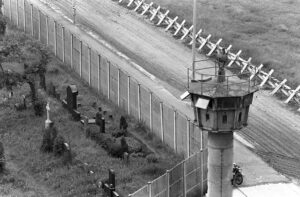 husband, who were sentenced to 2½ years. The three were eventually released with the help of Amnesty International.
husband, who were sentenced to 2½ years. The three were eventually released with the help of Amnesty International.
The families decided to initially settle in Naila where they had landed. Wetzel worked as an automobile mechanic and Strelzyk opened a TV repair shop in Bad Kissingen. Due to pressure from Stasi spies, the Strelzyks moved to Switzerland in 1985. After German reunification in 1990, they returned to their old home in their hometown of Pößneck. The Wetzels remained in Bavaria. Peter Strelzyk died in 2017 at age 74 after a long illness. In 2017, the balloon was put on permanent display at the Haus der Bayerischen Geschichte: Museum in Bavaria.

 My younger daughter, Amy Royce met her future husband, Travis Royce, when they were both still in high school. They knew that what they had was something special…something forever, and now, 29 years later, they are still going strong. They are so good together. They like doing the same things…except for the football teams they support. Travis likes the Chicago Bears and Amy likes the Green Bay Packers. For non-football fans, the two teams are bitter rivals. That said, they watch the games minus their spouse…it keeps the peace.
My younger daughter, Amy Royce met her future husband, Travis Royce, when they were both still in high school. They knew that what they had was something special…something forever, and now, 29 years later, they are still going strong. They are so good together. They like doing the same things…except for the football teams they support. Travis likes the Chicago Bears and Amy likes the Green Bay Packers. For non-football fans, the two teams are bitter rivals. That said, they watch the games minus their spouse…it keeps the peace.
I love how these two are together. Their house is always filled with laughter, because they both have a great sense of humor. Their jokes might be a little different, but both are very funny. They love entertaining their friends, and their house is truly the place everyone wants to hang out. Travis and their son, Caalab, along with several friends have a little band. They don’t usually go anywhere to play or charge admission for their concerts, but rather “jam” right there at the house. When they bought the house, it had a garage and recreation room, and now it is the local “T&Avern” and has everything from a pool table to bar tables. It’s a great place for them, their kids (Shai and Caalab Royce), and their friends to hang out.
Amy and Travis have a couple of places they like to go to celebrate their anniversaries. One is a quaint little 

 place called Ilwaco, in southwest Washington. The town (although I have not been there) reminds me a little bit of a place Bob and I like to go for our anniversaries…Thermopolis, Wyoming. Ilwaco is a little town of about 1,087 people, so there isn’t a whole lot to do but relax and walk around the area. That is what makes it so charming. They also took an Alaskan cruise last year, which they very much enjoyed. Since they live so close to Canada these days, they have also taken anniversary trips to Canada, as well.
place called Ilwaco, in southwest Washington. The town (although I have not been there) reminds me a little bit of a place Bob and I like to go for our anniversaries…Thermopolis, Wyoming. Ilwaco is a little town of about 1,087 people, so there isn’t a whole lot to do but relax and walk around the area. That is what makes it so charming. They also took an Alaskan cruise last year, which they very much enjoyed. Since they live so close to Canada these days, they have also taken anniversary trips to Canada, as well.
Amy and Travis are above all, best friends. They have been from the very start. They have an easy-going style and get along very well. They love the area they love in, being near the beaches, and being near enough to the big cities to go there sometimes, and far enough away so that they aren’t feeling like they are always in the big cities. Amy is a rain-lover!! I don’t know if Travis loves it as much as Amy does, but I think he likes it too. They 
 have a beautiful back yard, that Amy and Travis keep in tip top shape. He takes care the lawn, and she takes care of the flower gardens. They have ponds that are inhabited by “voluntary” frogs and snails. It’s nice when they don’t have to spend money of the inhabitants of the pond, because they just show up and move right in. Amy and Travis are quite happy with their life together, and that makes us very happy too. Today is Am and Travis’ 29th wedding anniversary. Happy anniversary Amy and Travis!! Have a great day!! We love you!!
have a beautiful back yard, that Amy and Travis keep in tip top shape. He takes care the lawn, and she takes care of the flower gardens. They have ponds that are inhabited by “voluntary” frogs and snails. It’s nice when they don’t have to spend money of the inhabitants of the pond, because they just show up and move right in. Amy and Travis are quite happy with their life together, and that makes us very happy too. Today is Am and Travis’ 29th wedding anniversary. Happy anniversary Amy and Travis!! Have a great day!! We love you!!
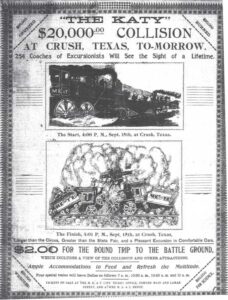
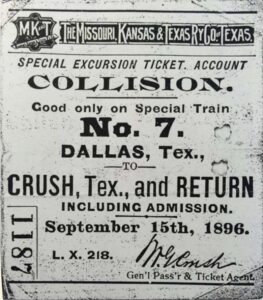 Some of the most horrific kinds of accidents that happen on the railroad are head-on collisions. In these types of accidents, it is almost always the fault of a person, commonly known as “human error.” Once in a while, the signal lights could be defective too, but that is less common than when the person responsible for watching the signal lights is “asleep” at their post, either literally or figuratively. However, on September 15, 1896, neither of these scenarios was the case. Nor was the ensuing crash a terrorist attack. It was actually a planned event. What would make a railway company purposely run two locomotives into each other, head-on? Your guess is as good as mine.
Some of the most horrific kinds of accidents that happen on the railroad are head-on collisions. In these types of accidents, it is almost always the fault of a person, commonly known as “human error.” Once in a while, the signal lights could be defective too, but that is less common than when the person responsible for watching the signal lights is “asleep” at their post, either literally or figuratively. However, on September 15, 1896, neither of these scenarios was the case. Nor was the ensuing crash a terrorist attack. It was actually a planned event. What would make a railway company purposely run two locomotives into each other, head-on? Your guess is as good as mine.
It was actually a publicity stunt. The area north of Waco, was a shallow valley near the tracks of the Missouri, Kansas, and Texas Railroad, also known as the Katy. There was no town there, so a “pop up” town, named Crush, Texas, was formed and was named after William George Crush, who was a passenger agent for the Katy. In 1895, Crush had the crazy idea of staging a train wreck as a way to generate passenger ticket sales. I’m not sure if I would want to buy a ticket for the train, if I had seen the possibility of a head-on collision come to life before my eyes, but apparently some people would. At that time, Texas, like much of the rest of the country, was in a serious economic depression, so Crush convinced the Katy company officials that his scheme would be a creative marketing ploy and attraction. I suppose we all tend to like to watch the spectacular, and a crash of that magnitude…knowing that now one would be hurt…would be interesting.
That summer, the Katy bombarded Texans with advertising for the “Monster Crash.” If they were going to purposely destroy two locomotives and the attached railcars, they wanted plenty of spectators. They put daily preparation reports in many newspapers, and the publicity even stretched beyond the state border. The two locomotives were chosen. They would use Old Number 999, which they painted green, and Number 1001, which they painted red. For a time, they two locomotives toured around to generate interest.
Thousands of Texans came out to see the locomotives during their tour, and then in early September several hundred Katy workmen began staging the town. Obviously not wanting to shut down the main line tracks for the cleanup that would have to follow the crash, they laid four miles of track off of the Waco-Dallas line that would be at a slight downward grade for both engines to the point of impact. A grandstand was constructed, along with three speaker’s stands, a bandstand, telegraph office, and a circus tent to act as a restaurant. The atmosphere was set with a huge carnival midway that featured game booths, drink stands, and medicine 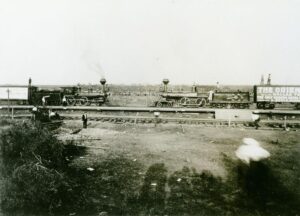 shows. And to put the final touch, they erected a special depot with a 2,100-foot platform and a sign welcoming passengers to Crush, Texas. I suppose it was similar to staging a movie these days.
shows. And to put the final touch, they erected a special depot with a 2,100-foot platform and a sign welcoming passengers to Crush, Texas. I suppose it was similar to staging a movie these days.
It was a known fact that in most collisions of this type, the engines would force each other up into a V and the rest of the cars would accordion behind them, making a boiler explosion less likely. Still, they didn’t want to take any chances, so they set up a safety perimeter of 150 yards around the pre-determined collision point and no one would be allowed in the danger zone. Crush told reporters, “The place selected for the collision is a natural amphitheater, and nobody will have any trouble viewing the entire exhibition.”
Tickets to the event were priced at $2.00, and they expected about 20,000 prople from around the state. What they got, was 40,000 people, and some passengers had too ride on top of railcars to get to the site. On that one day, the town of Crush, Texas became the second largest city in Texas. The event was scheduled for 4pm, but since people were still coming into town, they delayed the collision by one hour. Finally, at 5pm, the two locomotives, each pulling six cars moved into position at opposite ends of the four-mile track. Finally, the spectacle was ready. Crush rode a white horse to the middle of the track, raised his white hat, then after a dramatic pause, whipped it down as the signal for the engines to start. The crowd pressed forward for a better view, and the locomotive crews jumped to safety leaving the massive 35-ton iron monsters on their 50 mile per hour course to disaster. For dramatic effect, the Katy employees had placed small charges along the rail line to create warning blasts as the locomotives passed them.
Unfortunately, Crush and Katy rail officials had underestimated just how powerful the collision would be. The trains hit with between 1 and 2 million pounds of force, and despite what the engineers thought would happen, the boilers on both exploded. The sound of the collision was deafening, and the collision filled the air with flying metal. The panicked crowds tried to run to safety. The debris, ranging from the size of a postage stamp to half a driving wheel, rained down of the crowd for about 300 yards. Sadly, not everyone would make it out alive. At least two people were killed, and several injured. Shockingly, some of the injuries occurred after the crash when spectators rushed to collect souvenirs, not realizing it would burn their hands. Waco based photographer Jervice Deane, lost his right eye to a flying bolt that lodged in his skull. Amazingly, he survived the injury.
The planned disaster was quickly cleaned up by railroad crews and souvenir hunters, and by nightfall, the town of Crush ceased to exist. For his part in all this, Katy rail officials fired George Crush that night, because they 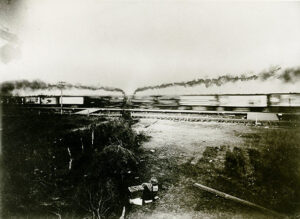
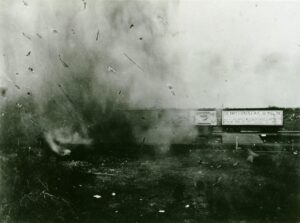 were anticipating a large backlash and lawsuits resulting from the larger than expected explosion. Nevertheless, the publicity stunt worked, train ticket sales increased. In a “back by popular demand” kind of move, Crush was re-hired within days. His days as a showman, however, were over. The railroad quietly settled the resulting lawsuits with cash and lifetime rail passes. Crush stayed on with the railroad until his retirement in 1940.
were anticipating a large backlash and lawsuits resulting from the larger than expected explosion. Nevertheless, the publicity stunt worked, train ticket sales increased. In a “back by popular demand” kind of move, Crush was re-hired within days. His days as a showman, however, were over. The railroad quietly settled the resulting lawsuits with cash and lifetime rail passes. Crush stayed on with the railroad until his retirement in 1940.

 Many little girls dream of becoming a princess. They may not dream of it for long, before reality sets in, but at some point, most little girls want to be a princess, even if it is just Cinderella. For one actress, Grace Kelly, that dream came true on April 18, 1956, when she married Prince Rainier III of Monaco. The couple met the year before at the Cannes Film Festival, went on to have three children…Caroline, born January 23, 1957; Albert II, born March 14, 1958; and Stephanie, born February 1, 1965.
Many little girls dream of becoming a princess. They may not dream of it for long, before reality sets in, but at some point, most little girls want to be a princess, even if it is just Cinderella. For one actress, Grace Kelly, that dream came true on April 18, 1956, when she married Prince Rainier III of Monaco. The couple met the year before at the Cannes Film Festival, went on to have three children…Caroline, born January 23, 1957; Albert II, born March 14, 1958; and Stephanie, born February 1, 1965.
Grace Kelly, the daughter of a former model and a wealthy industrialist, was born on November 12, 1929, in Philadelphia. Her talent was obvious early on, and she began acting as a child. Then, after high school, she attended the American Academy for Dramatic Arts in New York. She had found her niche…or so she thought.  After her schooling, she began to audition for Broadway plays. She was a classic blonde beauty, who supported herself by modeling and appearing in TV commercials, while awaiting her “big break.”
After her schooling, she began to audition for Broadway plays. She was a classic blonde beauty, who supported herself by modeling and appearing in TV commercials, while awaiting her “big break.”
In 1949, Kelly debuted on Broadway in a play called “The Father” by August Strindberg. She was on her way. Then two years later, she landed her first Hollywood part. Granted, it was a bit part, in a movie called “Fourteen Hours,” but it was a part. Her big break came in 1952, when she starred as Gary Cooper’s wife in the Western “High Noon.” Her performance in 1954’s “The Country Girl,” as the wife of an alcoholic actor and singer played by Bing Crosby, won her a Best Actress Oscar (Kelly beat out Judy Garland in “A Star is Born”). Among Kelly’s other acting credits were three Alfred Hitchcock thrillers: “Dial M for Murder” (1954), with Ray Milland and Robert Cummings, Rear Window (1954), with James Stewart, and “To Catch a Thief,” with Cary Grant. Her last big-screen role was in 1956’s “High Society,” a musical adaptation of 1940’s The Philadelphia Story, co-starring Bing Crosby and Frank Sinatra. By this time, Grace Kelly was on her way to retirement from the movies, because she was about to become a “real-life” princess. That little girl dream was going to come true for her…and for a number of years, Grace Kelly lived that dream.
Then, on September 14, 1982, her dream came to an end. Princess Grace of Monaco…the American-born 
 former film star Grace Kelly, whose movie credits include The Country Girl and Rear Window, and who was known as the darling of the United States, and the dream of many little girls, died at the age of 52 from injuries suffered after her car plunged off a mountain road near Monte Carlo. Princess Grace was driving with her youngest daughter, Stephanie, when she reportedly suffered a stroke and lost control of her car, which plunged down a mountainside. Seventeen-year-old Stephanie survived, but Princess Grace died the following day. Her death was mourned by millions of fans around the world.
former film star Grace Kelly, whose movie credits include The Country Girl and Rear Window, and who was known as the darling of the United States, and the dream of many little girls, died at the age of 52 from injuries suffered after her car plunged off a mountain road near Monte Carlo. Princess Grace was driving with her youngest daughter, Stephanie, when she reportedly suffered a stroke and lost control of her car, which plunged down a mountainside. Seventeen-year-old Stephanie survived, but Princess Grace died the following day. Her death was mourned by millions of fans around the world.

 Every kid gets excited about their birthday and being another year older. Most start saying they are their age and a half pretty early on, but for my grandniece, Mackenzie Moore, the excitement maybe went to the extreme. In fact, she’s been talking about turning seven since she turned six!! Hahaha!! So, to think the day has finally arrived is…well, the best birthday gift ever!! Oh, don’t get me wrong, I’m sure she is excited about birthday gifts and such, but being seven is just the coolest most important part of her birthday.
Every kid gets excited about their birthday and being another year older. Most start saying they are their age and a half pretty early on, but for my grandniece, Mackenzie Moore, the excitement maybe went to the extreme. In fact, she’s been talking about turning seven since she turned six!! Hahaha!! So, to think the day has finally arrived is…well, the best birthday gift ever!! Oh, don’t get me wrong, I’m sure she is excited about birthday gifts and such, but being seven is just the coolest most important part of her birthday.
Mackenzie is kind, and she has such a sweetheart. Like her mom, Lindsay Moore, Mackenzie is a social butterfly…she is a friend to everyone she meets. Mackenzie is truly a such a delightful person. She is easy going and fun. She loves her family and loves to be with them. Her grandmas and grandpas, aunts and uncles, and most of all…her cousins are a huge part of her life!! The summer, she got to spend time with her cousin Khloe from South Dakota; and lots of time with Adelaide Sawdon, who lives in Cheyenne, so not too far away. She and Addie play together often, and we try to get the girls together a lot. They build forts, make up games, and love to jump on the trampoline. Then, Mackenzie and Adelaide got to go camping with cousins, Ethan and Aurora Hadlock, and Jolene Thompson . The Hadlock family has had a long-standing tradition of camping together, and that has built a close comradery among the cousins. 

 Chelsea tells me that, Mackenzie is very funny, kind, and determined…and she is never interested in Uncle Ryan Hadlock’s teasing and nonsense. Hahahaha!!
Chelsea tells me that, Mackenzie is very funny, kind, and determined…and she is never interested in Uncle Ryan Hadlock’s teasing and nonsense. Hahahaha!!
She spent a lot of time practicing her gymnastics this summer and started officially this fall. So far, she loves it. and her hard work has paid off. She is very proud of her gymnastics skills and loves to show those skills as often as possible. She’s practiced the perfect cartwheel and executes it flawlessly each time she does it. Her aunt, Chelsea Hadlock, tells me that she is super good at them!! When Chelsea asked what she wanted for her birthday she said, “makeups and lotions, lip ‘skincare,’ soft scrunchies…Simone Biles things.” Chelsea really laughed about that. For those who don’t know, Simone Biles is an Olympic gymnast.
Mackenzie loves her daddy, Shannon Moore, very much!! They are two peas in a pod, and they love doing the same things. She also loves being in 1st grade!! Mackenzie has the sweetest heart. She is always considerate of everyone around her to make sure they are included and comfortable in all situations. She is a helper and always does what is right. She is also such a sweet friend. One place where Mackenzie shows maybe just a “hint” of stubbornness, is in the area of fashion. She has her own style, and it may not be like everyone else. 
 That doesn’t matter, because it is her style. She’s always been this way and knows exactly what she wants her outfits and hair to look like and will not be swayed, haha!! Her Aunt Jessi Sawdon and family love that they live so close and get to see her often! God has made her uniquely her…instilling her perfect gifts and talents. He has called her according to a purpose!! She is loved by God, loved by her family and her sweet little doggy Brinkley Bear. Today is Mackenzie’s 7th birthday!! You made it Mackenzie…six is gone and seven has arrived. Happy birthday Mackenzie!! Have a great day!! We love you!!
That doesn’t matter, because it is her style. She’s always been this way and knows exactly what she wants her outfits and hair to look like and will not be swayed, haha!! Her Aunt Jessi Sawdon and family love that they live so close and get to see her often! God has made her uniquely her…instilling her perfect gifts and talents. He has called her according to a purpose!! She is loved by God, loved by her family and her sweet little doggy Brinkley Bear. Today is Mackenzie’s 7th birthday!! You made it Mackenzie…six is gone and seven has arrived. Happy birthday Mackenzie!! Have a great day!! We love you!!

